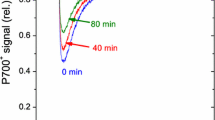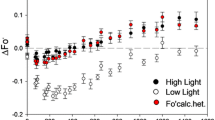Abstract.
Non-photochemical quenching of chlorophyll fluorescence (NPQ) and quantum yield of photosystem II (PSII) were studied with intact mesophyll chloroplasts of maize (Zea mays L.) during the initial minutes of illumination using the pulse-modulated chlorophyll fluorescence technique. Non-photochemical quenching was rapidly reversible in the dark at any point during illumination, which is indicative of energy-dependent dissipation of energy (mediated via thylakoid ΔpH changes and ascorbate-dependent synthesis of zeaxanthin). In chloroplasts suspensions including 15 mM ascorbate in the medium, with addition of oxaloacetate and pyruvate, the PSII yield, rate of reduction of oxaloacetate and phosphorylation of pyruvate reached a maximum after approximately 2 min of illumination. Under these conditions, which promote phosphorylation and a decreased ΔpH across the thylakoid membrane, NPQ rose to a maximum after 2–3 min of illumination, dropped to a minimum after about 6 min, and then increased to a steady-state level. A rather similar pattern was observed when leaves were illuminated following a 30-min dark period. Providing chloroplasts with higher levels of ascorbate (60 mM), prevented the transient drop in NPQ. Anaerobic conditions or addition of potassium cyanide caused a decrease in PSII yield, providing evidence for operation of the ascorbate-dependent Mehler-peroxidase reaction. These conditions also strongly suppressed the transient drop in NPQ. Dithiothreitol, an inhibitor of violaxanthin de-epoxidase, caused a large drop in NPQ even in the presence of high levels of ascorbate. The results suggest that the decline of NPQ occurs in response to an increase in lumen pH after initiation of phosphorylation, that this decline can be suppressed by conditions where ascorbate is not limiting for violaxanthin de-epoxidase, and that the increase of NPQ after such a decline is the result of development of energy dissipation in PSII reaction centers.
Similar content being viewed by others
Author information
Authors and Affiliations
Additional information
Received: 13 August 1999 / Accepted: 17 September 1999
Rights and permissions
About this article
Cite this article
Ivanov, B., Edwards, G. Influence of ascorbate and the Mehler peroxidase reaction on non-photochemical quenching of chlorophyll fluorescence in maize mesophyll chloroplasts. Planta 210, 765–774 (2000). https://doi.org/10.1007/s004250050678
Issue Date:
DOI: https://doi.org/10.1007/s004250050678




